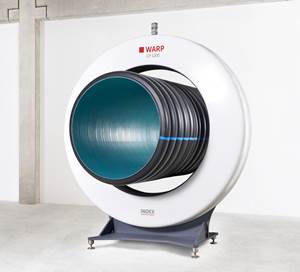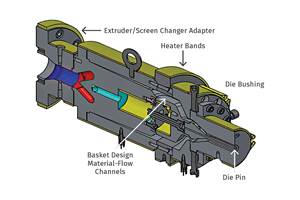Wheeler, Barrier Screw Pioneer, Dies at 96
Career at Davis-Standard spanned six decades.
Norton C. Wheeler, Jr., one of Davis-Standard’s most respected and accomplished technology innovators, passed away the end of September at his home in Mystic, Conn. He was 96.
Wheeler’s distinguished career at Davis-Standard spanned six decades. Even after his retirement in 1989, he remained engaged as a consultant until the age of 90. He is known as the father of the DSB (Davis-Standard Barrier) feedscrew, authored numerous technical papers, and mentored many Davis- Standard engineers. His list of contributions to Davis-Standard and the plastics industry in general is extensive. He was awarded Fellow of the Society of Plastics Engineers in 1985 and received the Bruce C. Maddock Award in 1998 for his pioneering work in research and development.
“I was honored to know Norton and work alongside him for so many years. He was a great mind, problem solver and infinite resource. He was also a wonderful human being, always willing to give of himself in his modest way,” said John Christiano, Davis-Standard’s Vice President of Extrusion Technology. “Our R&D capabilities and technical leadership began with Norton and he remained so vital to our work throughout his life. His achievements not only defined Davis-Standard as an R&D leader, but they changed the industry. He was truly one of a kind and will be dearly missed.”
Being part of Davis-Standard was in Wheeler’s blood. His grandfather, Charles E. Wheeler, was an original owner of Davis-Standard, purchasing the business as the Standard Machinery Company in 1904. His father Norton Sr. and his uncle John were instrument in assisting their father with modernizing and diversifying the operation. Under the leadership of Wheeler’s father, company president in the 1940s, and his new partner Benjamin Davis, the company transitioned from a manufacturer of compression molding presses before and during World War II into a post-war manufacturer of extrusion machinery. The
company became Davis-Standard in 1948.
Wheeler joined Davis-Standard in 1951 after serving in the U.S. Air Force and graduating from Brown University with a chemistry degree. Wheeler was a natural in the research environment. He spearheaded Davis-Standard’s first lab in the 1960s, growing the facility from a small space to a building equipped for customer trials and extensive R&D within a decade. During the following 20 years, he conducted revolutionary research with regard to feedscrew design and extrusion process control. Of all of his achievements, Wheler was most proud of the fact that Davis-Standard was the first company to fully instrument an extruder with multiple pressure transducers.
In the early 1980s, Wheeler patented the well-known DSB screw design. This design overcame limitations of existing barrier screws by optimizing the screw’s melt region, leading to improved stability and performance. The DSB quickly became the industry’s premier feedscrew and gave Davis-Standard a global technical presence. It also helped the company expand into multiple processing areas such as pipe and profile and sheet. The DSB continues to be the basis for all Davis-Standard screw designs.
Wheeler was predeceased by his wife of 69 years, Mary Anderson Wheeler, and is survived by their five children, six grandchildren and eight great-grandchildren.
Related Content
Wisconsin Firms Unite in Battle Against Covid
Teel Plastics opened new plant in record time, partnering with AEC & Aqua Poly Equipment Co. to expand production of swab sticks to fight pandemic.
Read MoreHigh-Speed Cutters for Corrugated Tubing
Applications for new cutter line include medical, automotive, and other industrial.
Read MoreRadar-Based Wall-Thickness Sensor
Measurement units include an array of these sensors positioned around the circumference of the pipe, which can be placed in multiple locations on an extrusion line.
Read MoreHow to Select the Right Tooling for Pipe Extrusion
In pipe extrusion, selecting or building a complementary set of tooling often poses challenges due to a range of qualitative factors. Here’s some guidance to help you out.
Read MoreRead Next
People 4.0 – How to Get Buy-In from Your Staff for Industry 4.0 Systems
Implementing a production monitoring system as the foundation of a ‘smart factory’ is about integrating people with new technology as much as it is about integrating machines and computers. Here are tips from a company that has gone through the process.
Read MoreBeyond Prototypes: 8 Ways the Plastics Industry Is Using 3D Printing
Plastics processors are finding applications for 3D printing around the plant and across the supply chain. Here are 8 examples to look for at NPE 2024.
Read MoreMaking the Circular Economy a Reality
Driven by brand owner demands and new worldwide legislation, the entire supply chain is working toward the shift to circularity, with some evidence the circular economy has already begun.
Read More

























